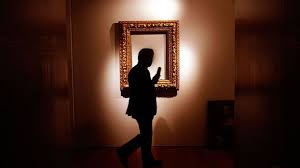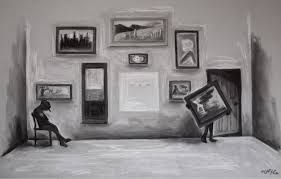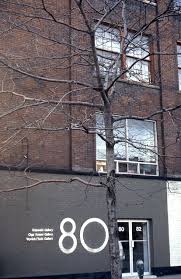Toronto Art Crimes, Part Two
Posted by Deirdre | Filed under Blog

(After I investigated Toronto art dealer Olga Korper’s theft of art work and funds belonging to Yves Gaucher, the only artist to go on the record about corruption at the gallery contracted to represent him, my front page Globe and Mail story caught the attention of other artists at other galleries who had also been fleeced by their dealers. A group of artists came to my workplace to implore me to help them locate their dealers who had absconded with work and money owed them on sales. They could get no help from PADAC, aka the Professional Art Dealers Association of Canada, where then president Fela Grunwald said that while aware of violations by her association’s members, including by Olga Korper, she could not enforce the association’s standards— begging the question then what was the organization good for? I reported on the thefts and resulting arrest of one of the dealers I successfully located in Toronto for police. I found his partner living the good life in the Caribbean where my Editor sent me to get the scoop. My months-long investigation was published in the Globe and was never contested, meaning the facts hold true. I reprint the story here to refresh people’s memories of what went on. There is no doubt that artists were shafted and that unethical practices were allowed to flourish unchecked. These stories are being resurrected in light of Korper, one of the dealers who did her artists wrong, has recently been named to the Order of Canada. This is a travesty. The hope that the public would be outraged to the point that crooked dealers are held accountable for their actions and not be lauded for crimes against Canadian culture.)
HOW A CROOKED TORONTO ART DEALER RIPPED OFF HIS ARTISTS AND SEEMINGLY GOT AWAY WITH IT
by Deirdre Kelly
Two prominent Toronto art dealers have been charged with theft and fraud from Canadian artists allegedly involving art and revenue worth an estimated $200,000.
Toronto police issued a warrant yesterday for Frank Costin, 40, currently living on the Caribbean island of Anguilla. His partner, John Klintworth, 39, was arrested in Toronto Saturday after a year-long investigation by police, then released on his own recognizance.
Both have been charged with 14 counts of theft and fraud related to an estimated $206,000 worth of missing sales proceeds and unsold works given them on consignment when they were joint owners of the Costin & Klintworth Gallery, a leading showplace of Canadian contemporary art until its 1996 closing.
If convicted, Mr. Costin and Mr. Klintworth could serve prison terms of up to 10 years each. However, Canadian law-enforcement officials say it may be difficult to return Mr. Costin to Canada now that he is living in Anguilla, which does not have an extradition treaty with Canada.
Although many Canadian artists have complained for years about the largely unregulated business practices of their dealers, this is believed to be the first time that fraud and theft charges have been laid.
The charges stem from a formal complaint made by five artists represented by Mr. Costin and Mr. Klintworth, who established their gallery in 1987. It is alleged that at the time of the gallery’s demise, some artists were left without payment for work sold between 1990 and 1996, and some of their work went missing.
Wynona Mulcaster, 82, a Saskatchewanian now living in San Miguel de Allende, Mexico, says she was one of the affected artists. She alleges she is owed $27,000 on sales of her drawings and paintings, after the 40 per cent commission taken by Costin & Klintworth. “This is the second time a Canadian gallery has folded and not paid me what it should have,” Ms. Mulcaster said. “I’m interested in painting, in art, and in good will. I’m not interested in muck-raking. I just hope these young men find a way to pay their debts and not go to court.”

But police say it is too late, now that charges have been laid. The investigation into the artists’ complaints was conducted by Detectives Mike Stowell and Fiona Greenaway of the Toronto police. Four other artists besides Ms. Mulcaster filed a collective complaint with Toronto police late in 1996. They are: David Alexander, 50, of Saskatoon, who said he is owed $19,000 for missing art with a gross value of $38,000 (Costin & Klintworth received a 50-per-cent commission for sales of his paintings and drawings); Michael Davey, 48, a Toronto sculptor, who says he is owed $4,000; David Wright, a 49-year-old Toronto painter, who says he is owed $3,000 for works sold; and Alex Cameron, 50, of Toronto, who says he is owed $5,000 for missing work with a gross value of $10,000.
Two other artists — John Brown and K. M. (Kate) Graham — named in the claim filed by the five — allege they are owed, respectively, $10,000 and $20,000 by the dealers. However, they are not signatories to the complaint seeking redress.
The Costin & Klintworth Gallery was a member of the Professional Art Dealers Association of Canada, a trade organization with a published code of ethics. At one time Mr. Costin was a member of PADAC’s board of directors, but he was dismissed from the board in 1994 for alleged irregular business dealings. A spokesperson for PADAC said the organization is “not legally empowered to enforce” its standards.
“The options that we have are to expel a member or offer mediation. We are a trade organization, not a policing association,” PADAC president Fela Grunwald said yesterday.
Some of the missing art work has been turning up in different collections in Toronto. One of David Alexander’s missing paintings, Softer Walls (1992), for instance, is now at the University of Toronto’s Hart House. Ron Kaplansky, a Toronto graphic designer and art collector, said he purchased the work almost six years ago from Costin & Klintworth and recently donated it to the university. However, Mr. Alexander says he was never paid for the painting.
Mr. Costin and Mr. Klintworth say they do not know the whereabouts of the missing works. “I wouldn’t know about that,” Mr. Klintworth said last spring. “I wasn’t directly involved in the end there.”

Interviewed on Anguilla last March, Mr. Costin said: “I am not currently in possesion of any of their art.”
After leaving Toronto, Mr. Costin opened a new gallery in November of 1996 with a new roster of artists in Anguilla, a British dependent territory of 8,000 and an offshore tax haven for many Canadians. The Savannah Gallery represents Caribbean works, not Canadian, Mr. Costin said.
When visited by The Globe in Anguilla, Mr. Costin avoided most questions about his former gallery, saying he needed to get “the correct response” from his lawyer, who works for the Toronto law firm McCarthy Tetrault. Mr. Costin’s brother Abraham (Bram), an avid art collector, is a specialist there in commercial real-estate law.
Mr. Costin described his new Caribbean life as “idyllic.” He rents part of an imposing white palazzo with views of the Caribbean and nearby St. Barths. He also owns a white Mitsubishi, registered in his name, and on days off often heads for Savannah Bay, where he is a regular at the Palm Grove Bar and Grill.
The Savannah Gallery is housed in a 112-year-old historical building in a commercial and residential area known as The Valley. The former computer store, which Mr. Costin rents, is now an airy space with shuttered windows painted in pastels.
The gallery caters mostly to the white tourist trade. The work, most of it produced by white expatriate artists from Canada and the U.S. living in Anguilla, as well as artists from Haiti, Dominica and Jamaica, sells in U.S. dollars, with prices ranging from $30 for hand-woven baskets to about $5,000 for oil paintings.
Artists now represented by Mr. Costin said that they do not have written contracts with him, but that he has paid them for works sold. “He sends me my share and he also includes an invoice with the name of the print and, if it has a number, a number, and the date of purchase,” said Jo-Anne Hill Saunders, subject of a one-woman show last March. “We both have computers and they know that I keep my own records.”
If Mr. Costin appears to have prospered since closing his Toronto gallery, the same can’t be said of Mr. Klintworth, who is HIV-positive. He has also been on social assistance since at least February, 1996 — four months before the gallery closed its doors. He received general welfare payments through the end of July, 1996, while working at the time as an art consultant for the Toronto law firm Osler, Hoskin, Harcourt.
Mr. Klintworth and Mr. Costin first met in the 1970s when both worked for the late Toronto art dealer Jack Pollock. When Mr. Costin closed their gallery, he changed the locks without Mr. Klintworth’s knowledge. Mr. Costin said he had to shut out his partner after an economic downturn that made the gallery untenable, and a decline in Mr. Klintworth’s health.
Mr. Costin and Mr. Klintworth will now only likely see each other again in court. But it may take a long time: Even with a warrant for Mr. Costin’s arrest, Canadian or Anguillan police cannot physically remove him from the Caribbean to face charges in Toronto.
Last spring, framed against a blue Caribbean sky, Mr. Costin said: “Every day I thank God for giving me a chance to start over again.”
